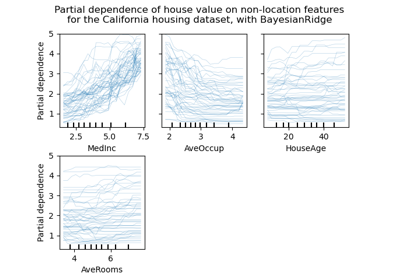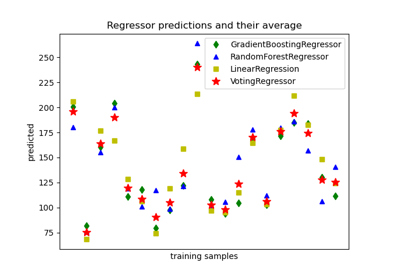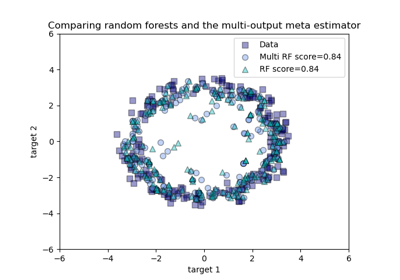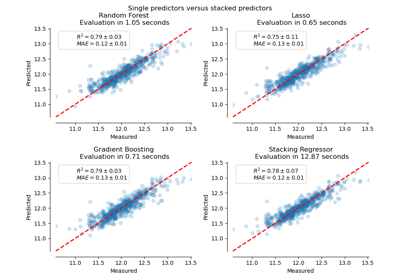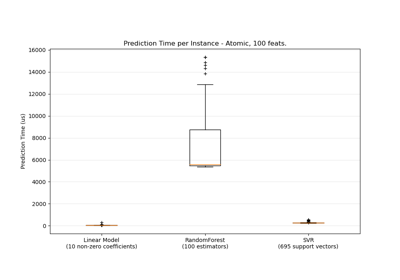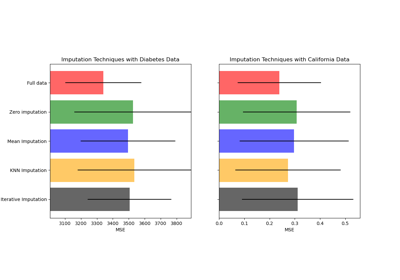sklearn.ensemble.RandomForestRegressor¶
-
class
sklearn.ensemble.RandomForestRegressor(n_estimators=100, *, criterion='mse', max_depth=None, min_samples_split=2, min_samples_leaf=1, min_weight_fraction_leaf=0.0, max_features='auto', max_leaf_nodes=None, min_impurity_decrease=0.0, min_impurity_split=None, bootstrap=True, oob_score=False, n_jobs=None, random_state=None, verbose=0, warm_start=False, ccp_alpha=0.0, max_samples=None)[source]¶ A random forest regressor.
A random forest is a meta estimator that fits a number of classifying decision trees on various sub-samples of the dataset and uses averaging to improve the predictive accuracy and control over-fitting. The sub-sample size is controlled with the
max_samplesparameter ifbootstrap=True(default), otherwise the whole dataset is used to build each tree.Read more in the User Guide.
- Parameters
- n_estimatorsint, default=100
The number of trees in the forest.
Changed in version 0.22: The default value of
n_estimatorschanged from 10 to 100 in 0.22.- criterion{“mse”, “mae”}, default=”mse”
The function to measure the quality of a split. Supported criteria are “mse” for the mean squared error, which is equal to variance reduction as feature selection criterion, and “mae” for the mean absolute error.
New in version 0.18: Mean Absolute Error (MAE) criterion.
- max_depthint, default=None
The maximum depth of the tree. If None, then nodes are expanded until all leaves are pure or until all leaves contain less than min_samples_split samples.
- min_samples_splitint or float, default=2
The minimum number of samples required to split an internal node:
If int, then consider
min_samples_splitas the minimum number.If float, then
min_samples_splitis a fraction andceil(min_samples_split * n_samples)are the minimum number of samples for each split.
Changed in version 0.18: Added float values for fractions.
- min_samples_leafint or float, default=1
The minimum number of samples required to be at a leaf node. A split point at any depth will only be considered if it leaves at least
min_samples_leaftraining samples in each of the left and right branches. This may have the effect of smoothing the model, especially in regression.If int, then consider
min_samples_leafas the minimum number.If float, then
min_samples_leafis a fraction andceil(min_samples_leaf * n_samples)are the minimum number of samples for each node.
Changed in version 0.18: Added float values for fractions.
- min_weight_fraction_leaffloat, default=0.0
The minimum weighted fraction of the sum total of weights (of all the input samples) required to be at a leaf node. Samples have equal weight when sample_weight is not provided.
- max_features{“auto”, “sqrt”, “log2”}, int or float, default=”auto”
The number of features to consider when looking for the best split:
If int, then consider
max_featuresfeatures at each split.If float, then
max_featuresis a fraction andround(max_features * n_features)features are considered at each split.If “auto”, then
max_features=n_features.If “sqrt”, then
max_features=sqrt(n_features).If “log2”, then
max_features=log2(n_features).If None, then
max_features=n_features.
Note: the search for a split does not stop until at least one valid partition of the node samples is found, even if it requires to effectively inspect more than
max_featuresfeatures.- max_leaf_nodesint, default=None
Grow trees with
max_leaf_nodesin best-first fashion. Best nodes are defined as relative reduction in impurity. If None then unlimited number of leaf nodes.- min_impurity_decreasefloat, default=0.0
A node will be split if this split induces a decrease of the impurity greater than or equal to this value.
The weighted impurity decrease equation is the following:
N_t / N * (impurity - N_t_R / N_t * right_impurity - N_t_L / N_t * left_impurity)
where
Nis the total number of samples,N_tis the number of samples at the current node,N_t_Lis the number of samples in the left child, andN_t_Ris the number of samples in the right child.N,N_t,N_t_RandN_t_Lall refer to the weighted sum, ifsample_weightis passed.New in version 0.19.
- min_impurity_splitfloat, default=None
Threshold for early stopping in tree growth. A node will split if its impurity is above the threshold, otherwise it is a leaf.
Deprecated since version 0.19:
min_impurity_splithas been deprecated in favor ofmin_impurity_decreasein 0.19. The default value ofmin_impurity_splithas changed from 1e-7 to 0 in 0.23 and it will be removed in 1.0 (renaming of 0.25). Usemin_impurity_decreaseinstead.- bootstrapbool, default=True
Whether bootstrap samples are used when building trees. If False, the whole dataset is used to build each tree.
- oob_scorebool, default=False
Whether to use out-of-bag samples to estimate the generalization score. Only available if bootstrap=True.
- n_jobsint, default=None
The number of jobs to run in parallel.
fit,predict,decision_pathandapplyare all parallelized over the trees.Nonemeans 1 unless in ajoblib.parallel_backendcontext.-1means using all processors. See Glossary for more details.- random_stateint, RandomState instance or None, default=None
Controls both the randomness of the bootstrapping of the samples used when building trees (if
bootstrap=True) and the sampling of the features to consider when looking for the best split at each node (ifmax_features < n_features). See Glossary for details.- verboseint, default=0
Controls the verbosity when fitting and predicting.
- warm_startbool, default=False
When set to
True, reuse the solution of the previous call to fit and add more estimators to the ensemble, otherwise, just fit a whole new forest. See the Glossary.- ccp_alphanon-negative float, default=0.0
Complexity parameter used for Minimal Cost-Complexity Pruning. The subtree with the largest cost complexity that is smaller than
ccp_alphawill be chosen. By default, no pruning is performed. See Minimal Cost-Complexity Pruning for details.New in version 0.22.
- max_samplesint or float, default=None
If bootstrap is True, the number of samples to draw from X to train each base estimator.
If None (default), then draw
X.shape[0]samples.If int, then draw
max_samplessamples.If float, then draw
max_samples * X.shape[0]samples. Thus,max_samplesshould be in the interval(0, 1).
New in version 0.22.
- Attributes
- base_estimator_DecisionTreeRegressor
The child estimator template used to create the collection of fitted sub-estimators.
- estimators_list of DecisionTreeRegressor
The collection of fitted sub-estimators.
feature_importances_ndarray of shape (n_features,)The impurity-based feature importances.
- n_features_int
The number of features when
fitis performed.- n_outputs_int
The number of outputs when
fitis performed.- oob_score_float
Score of the training dataset obtained using an out-of-bag estimate. This attribute exists only when
oob_scoreis True.- oob_prediction_ndarray of shape (n_samples,)
Prediction computed with out-of-bag estimate on the training set. This attribute exists only when
oob_scoreis True.
See also
DecisionTreeRegressor,ExtraTreesRegressor
Notes
The default values for the parameters controlling the size of the trees (e.g.
max_depth,min_samples_leaf, etc.) lead to fully grown and unpruned trees which can potentially be very large on some data sets. To reduce memory consumption, the complexity and size of the trees should be controlled by setting those parameter values.The features are always randomly permuted at each split. Therefore, the best found split may vary, even with the same training data,
max_features=n_featuresandbootstrap=False, if the improvement of the criterion is identical for several splits enumerated during the search of the best split. To obtain a deterministic behaviour during fitting,random_statehas to be fixed.The default value
max_features="auto"usesn_featuresrather thann_features / 3. The latter was originally suggested in [1], whereas the former was more recently justified empirically in [2].References
- 1
Breiman, “Random Forests”, Machine Learning, 45(1), 5-32, 2001.
- 2
P. Geurts, D. Ernst., and L. Wehenkel, “Extremely randomized trees”, Machine Learning, 63(1), 3-42, 2006.
Examples
>>> from sklearn.ensemble import RandomForestRegressor >>> from sklearn.datasets import make_regression >>> X, y = make_regression(n_features=4, n_informative=2, ... random_state=0, shuffle=False) >>> regr = RandomForestRegressor(max_depth=2, random_state=0) >>> regr.fit(X, y) RandomForestRegressor(...) >>> print(regr.predict([[0, 0, 0, 0]])) [-8.32987858]
Methods
apply(X)Apply trees in the forest to X, return leaf indices.
Return the decision path in the forest.
fit(X, y[, sample_weight])Build a forest of trees from the training set (X, y).
get_params([deep])Get parameters for this estimator.
predict(X)Predict regression target for X.
score(X, y[, sample_weight])Return the coefficient of determination \(R^2\) of the prediction.
set_params(**params)Set the parameters of this estimator.
-
apply(X)[source]¶ Apply trees in the forest to X, return leaf indices.
- Parameters
- X{array-like, sparse matrix} of shape (n_samples, n_features)
The input samples. Internally, its dtype will be converted to
dtype=np.float32. If a sparse matrix is provided, it will be converted into a sparsecsr_matrix.
- Returns
- X_leavesndarray of shape (n_samples, n_estimators)
For each datapoint x in X and for each tree in the forest, return the index of the leaf x ends up in.
-
decision_path(X)[source]¶ Return the decision path in the forest.
New in version 0.18.
- Parameters
- X{array-like, sparse matrix} of shape (n_samples, n_features)
The input samples. Internally, its dtype will be converted to
dtype=np.float32. If a sparse matrix is provided, it will be converted into a sparsecsr_matrix.
- Returns
- indicatorsparse matrix of shape (n_samples, n_nodes)
Return a node indicator matrix where non zero elements indicates that the samples goes through the nodes. The matrix is of CSR format.
- n_nodes_ptrndarray of shape (n_estimators + 1,)
The columns from indicator[n_nodes_ptr[i]:n_nodes_ptr[i+1]] gives the indicator value for the i-th estimator.
-
property
feature_importances_¶ The impurity-based feature importances.
The higher, the more important the feature. The importance of a feature is computed as the (normalized) total reduction of the criterion brought by that feature. It is also known as the Gini importance.
Warning: impurity-based feature importances can be misleading for high cardinality features (many unique values). See
sklearn.inspection.permutation_importanceas an alternative.- Returns
- feature_importances_ndarray of shape (n_features,)
The values of this array sum to 1, unless all trees are single node trees consisting of only the root node, in which case it will be an array of zeros.
-
fit(X, y, sample_weight=None)[source]¶ Build a forest of trees from the training set (X, y).
- Parameters
- X{array-like, sparse matrix} of shape (n_samples, n_features)
The training input samples. Internally, its dtype will be converted to
dtype=np.float32. If a sparse matrix is provided, it will be converted into a sparsecsc_matrix.- yarray-like of shape (n_samples,) or (n_samples, n_outputs)
The target values (class labels in classification, real numbers in regression).
- sample_weightarray-like of shape (n_samples,), default=None
Sample weights. If None, then samples are equally weighted. Splits that would create child nodes with net zero or negative weight are ignored while searching for a split in each node. In the case of classification, splits are also ignored if they would result in any single class carrying a negative weight in either child node.
- Returns
- selfobject
-
get_params(deep=True)[source]¶ Get parameters for this estimator.
- Parameters
- deepbool, default=True
If True, will return the parameters for this estimator and contained subobjects that are estimators.
- Returns
- paramsdict
Parameter names mapped to their values.
-
predict(X)[source]¶ Predict regression target for X.
The predicted regression target of an input sample is computed as the mean predicted regression targets of the trees in the forest.
- Parameters
- X{array-like, sparse matrix} of shape (n_samples, n_features)
The input samples. Internally, its dtype will be converted to
dtype=np.float32. If a sparse matrix is provided, it will be converted into a sparsecsr_matrix.
- Returns
- yndarray of shape (n_samples,) or (n_samples, n_outputs)
The predicted values.
-
score(X, y, sample_weight=None)[source]¶ Return the coefficient of determination \(R^2\) of the prediction.
The coefficient \(R^2\) is defined as \((1 - \frac{u}{v})\), where \(u\) is the residual sum of squares
((y_true - y_pred) ** 2).sum()and \(v\) is the total sum of squares((y_true - y_true.mean()) ** 2).sum(). The best possible score is 1.0 and it can be negative (because the model can be arbitrarily worse). A constant model that always predicts the expected value ofy, disregarding the input features, would get a \(R^2\) score of 0.0.- Parameters
- Xarray-like of shape (n_samples, n_features)
Test samples. For some estimators this may be a precomputed kernel matrix or a list of generic objects instead with shape
(n_samples, n_samples_fitted), wheren_samples_fittedis the number of samples used in the fitting for the estimator.- yarray-like of shape (n_samples,) or (n_samples, n_outputs)
True values for
X.- sample_weightarray-like of shape (n_samples,), default=None
Sample weights.
- Returns
- scorefloat
\(R^2\) of
self.predict(X)wrt.y.
Notes
The \(R^2\) score used when calling
scoreon a regressor usesmultioutput='uniform_average'from version 0.23 to keep consistent with default value ofr2_score. This influences thescoremethod of all the multioutput regressors (except forMultiOutputRegressor).
-
set_params(**params)[source]¶ Set the parameters of this estimator.
The method works on simple estimators as well as on nested objects (such as
Pipeline). The latter have parameters of the form<component>__<parameter>so that it’s possible to update each component of a nested object.- Parameters
- **paramsdict
Estimator parameters.
- Returns
- selfestimator instance
Estimator instance.

